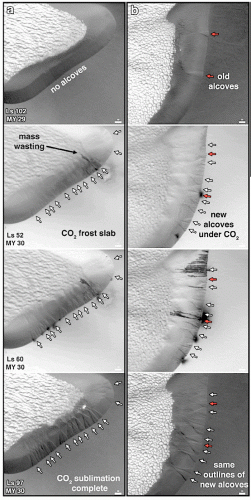The sand sea surrounding the Martian north pole covers an area about a third the size of Earth’s Arabian Desert and is roughly equal in size to the Kalahari. Dunes are a common feature on Mars, just as in terrestrial sand sheets.

BLOW, SLIP, SLIDE. Winds, not evaporating CO2 frost, appear to cause alcoves and fans to form on dunes in Mars' north polar sand sea. The little white scale bars in the lower right corner of each panel measure 10 meters (33 feet) long. (Image taken from Figure 2 in the paper.)
Many Martian dunes appear active today and show features similar to those on terrestrial dunes, including ripples, steep lee-side slopes, alcoves, and fans. Produced by a sand avalanche, an alcove is a shallow, wedge-shaped depression at the top of a dune’s lee slope, while a fan of debris from the alcove lies below. On some dunes a short channel connects the two.
On Earth, avalanche-caused alcoves typically measure a few inches to a foot wide; on Mars however, they span a yard to tens of yards wide, for reasons that scientists haven’t yet figured out.
Scientists have also argued over what starts the formation of an avalanche and alcove on the north polar dunes. One suggested cause is a disturbance when the seasonal slab of carbon dioxide frost vigorously sublimates (evaporates directly into a gas) as spring sunlight warms it. The CO2 explanation has been popular because alcove features are seen clearly on dunes after the CO2 frost has gone, but they were not visible in images taken early in the previous summer.
However, a recent paper in Geophysical Research Letters by Briony Horgan and James Bell (both Arizona State University) points to winds as a more likely cause. The researchers used new meter-scale images from the HiRISE camera on Mars Reconnaissance Orbiter to track changes in north polar dunes during Mars Years 28 to 30 (Jan 2006 to Sept 2011).
The new images captured a more complete time sequence, which showed that alcoves and fans were already present underneath the CO2 frost slab as winter began. In addition, other clues such as orientation pointed to winds as the trigger.
The dominant wind direction is thought to be easterly, based on the shape of the dunes, the researchers note, but the alcove orientations don’t match easterly winds everywhere. “The alcoves line up with the easterly winds in only the western part of the sand sea, but elsewhere they line up really well with fresh ripples, which are a good indicator of the most recent winds,” the scientists say.
“The summer timeframe of formation, association with dune activity, and possible relationship with recent winds all suggest an origin for the alcoves related to eolian processes,” they conclude. “A very small flow starts on the dune slipface, creating an initial breakaway scarp, which expands laterally and moves upslope, forming an alcove at the dune brink.”
The researchers note that a lot of their insight on the processes involving in this hypothesis came from studying terrestrial sand dunes, especially those like the ones at White Sands National Monument in New Mexico and Great Sand Dunes National Park in Colorado. Says Bell, “Geologic features and environments on our own planet often provide excellent natural laboratories and analogs for understand what is happening on other worlds — and vice versa!”








